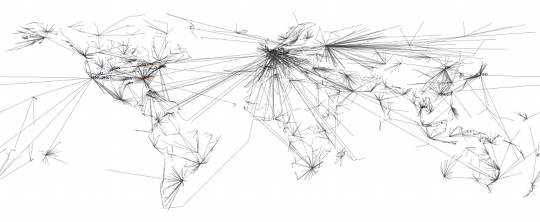The team compared the entire worldwide air transportation network before and after the 27 major European airports were closed and used complex network theory to compute and list the most affected airports still operating.
"We were surprised to discover that at the top of the list were airports outside of Europe, not airports in Europe," Northwestern University professor Dirk Brockmann said. "Singapore, Hong Kong and Beijing are some of the high-traffic airports most affected, despite being geographically distant from Europe and separated from Iceland by continents."

Shortest-path-tree analysis reveals and quantifies the effect of airport closures on global traffic
(Photo credit: North Western University)
More images available here.
Researchers found that airports like Madrid and Dubai have become more central in the entire air transportation network, taking over the role of the closed airports.
"European airports are bridges to the world -- the majority of global air traffic goes through Europe," Brockmann said. "The distances to places have increased globally as a result of the volcanic ash disruption. Mumbai, for example, has become more disconnected than we expected from the U.S. and Africa. Flights from the U.S. to Mumbai normally go through Europe, but now Mumbai is a more distant city to us."
A trip that may have required two flights before the volcano's eruption might have taken four or five trips when the situation was at its worst, which translates into more time, says Brockmann.
At the peak of the disruption, with the 27 major European airports closed, 10 percent of the entire global air traffic system was removed. The slowdown in air traffic affected not only the mobility of people but that of fresh vegetables and fruit, grains and other food, medicine, machinery parts and more.
"The removal of those 27 nodes dramatically affects the entire complex system," said Brockmann. "We can quantify Eyjafjallajökull's effect and illustrate it, which is not a simple thing to do."
"In this case, the entire air transportation system was slowed but still works," said Brockmann. "Our calculations show that an actual system breakdown requires the removal of 80 percent of the airports from the system. This shows how robust the system is."
The researchers next plan to make a comparative analysis of the Eyjafjallajökull's event and the effects of 9/11 on air traffic and mobility.






Comments